#prairie flax
Note
I like that most Canadian food is local, but how local?
Imagine a hypothetical(👀) Great Depression scenario where the logistics of driving produce to market gets priced out. Could Canada adapt?
In the US, a large portion of farms are a little southwest to dead center on the continent. The commute distance is so far that harvest happens before the produce is ripe so that it won't rot in the grocery store. If the trucks can't drive for whatever reason, a lot of people are going hungry.
Is Canadian food produced close enough to population centers to work out alternative means of supply? Maybe they could meet each other halfway?
When I say local, I mean local, less than one-twelfth of Canada's land is utilized for farming and crop production, southwestern Bristish Columbia and southern Ontario have the highest yield and widest range of crops, while farms can be found across basically every province.
The majority of wheat is grown on the Prairies, but you'll also find wheat fields in British Columbia, Ontario, Quebec, Prince Edward Island and Nova Scotia.
In 2018, Canada was the world's largest producer of rapeseed, dry pea and lentil, the 2nd largest producer of oats in the world, the 6th largest world producer of wheat and barley, the 7th largest world producer of soy, the 10th largest world producer of corn and the 12th largest world producer of potato.
In the same year, the country also produced 688 thousand tons of flax, 505 thousand tons of sugar beet, which is used to produce sugar, 497 thousand tons of tomato, 424 thousand tons of apple, 354 thousand tons of carrots, 341 thousand tons of beans, 311 thousand tons of chickpeas, 236 thousand tons of rye, 240 thousand tons of onion, 219 thousand tons of cabbage, 195 thousand tons of cranberry, 164 thousand tons of blueberry, 173 thousand tons of mustard seed, 138 thousand tons of mushroom and truffle, 120 thousand tons of grape, in addition to smaller productions of other agricultural products.
That's just numbers, your question pertains to how it would get around, well, if Canada were to lose our infrastructure to ship said crops and produce, we'd fair pretty well, I live in a city and it is surrounded by farmland, there are local markets, local butchers, local orchards, local, well, everything apart from the more exotic options.
Hell, I can go into the woods and find wild variants of local crops just growing, won't taste good, but they do in a pinch, then there is the fact only 5% of Canada has infrastructure, 95% is wilderness, really, the only industry that would take a hit would be dairy.
Oh, and yes, major cities like Toronto and Ottawa will be fucked, but I don't really care about Toronto or Ottawa, as they're basically the Canadian London and DC.
Like, look at the population density of Canada;

We all live along the border, now compare it to the farm map of Canada;
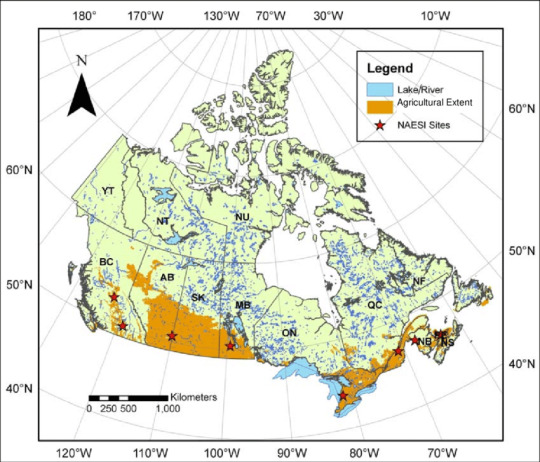
We'd be fine.
8 notes
·
View notes
Text
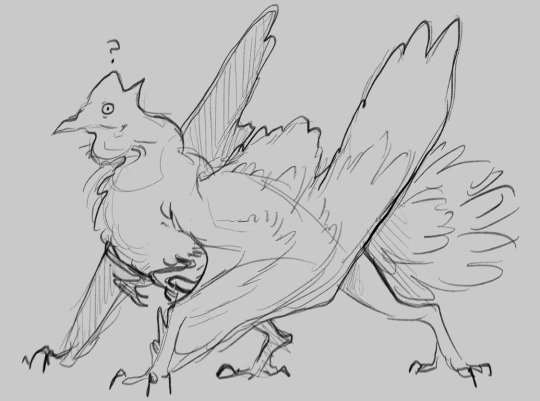
CHICKENS
Chickens, named verbally by humans after the Old World creatures of a similar disposition, are a widely distributed livestock animal kept for their meat and feathers. Chickens have been shaped by generations of selective breeding prior to Human arrival to grow and shed an impressive amount of their coats, which are comprised of sturdy, hollow “pinfeathers” that contain softer fibers within, much like a flax plant. The sheddings are then collected and woven into a material called featherwool, which was the most common textile prior to the appearance of Human animals with the Santiago and still sees prolific use to the modern day, though it sees fair competition with the introduction of manewool (see Sheep). The Dragonsign name for chickens can be roughly translated to “featherfriend”*.
Traditionally, chicken feathers were collected from the ground with a wide rake and then sieved and washed to remove dirt and debris before being processed. Since the arrival of humans gave birth to widespread industrial revolution, this process has been automated in various manners, though it’s still done manually in many smaller settlements.
*Many widespread dialects of Dragonsign have two base words for animals, one meaning, generally, “animal who is a friend”, referring to domesticated animals and pets, and one meaning “animal who is not a friend”, referring to any non-domesticated animal (regardless of hostility). Prefixes are then attached to these words to give more specific meaning. The sign that has been translated here as feather for brevity refers specifically to the hollow fiber-feathers grown by domestic chickens, as opposed to other types of flimsier branching feathers that make up the decorative frills of many Dragons.
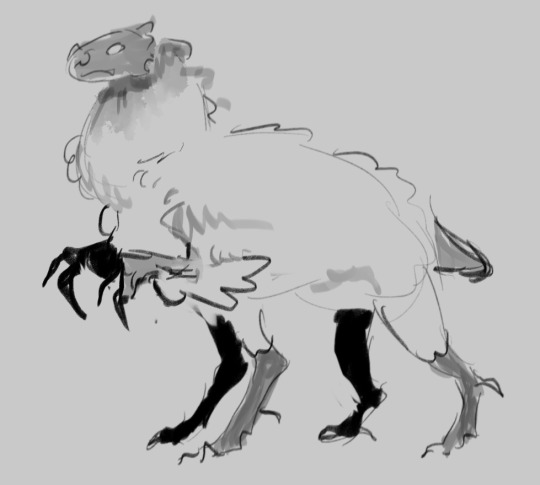
SHEEP
Sheep were named so as the successors of Old World sheep, who were introduced to Alcoritrés with the Santiago and, after mingling extensively with several local species of wild herbivores – most notably the cold-blooded greenrunners* native to nearby prairies, which led to the predominant modern-day hybrid pictured above – proceeded to thin out and almost entirely die off after a few generations or so due to their inability to evolve fast enough to survive the harsh weather that differentiated Alcoritrés grasslands from their previous pastures, leaving their genes behind in the form of their fortified hybrid offspring.
As a result, the sustained wide-scale rearing of domestic sheep on Alcoritrés only truly dates back about ~2950 years, by which time the recently-arrived Humans had recovered both the resource capacity to settle down with livestock and the hands-on knowledge of how to raise and interact with the newly-bred species.
In the modern day, sheep are kept for their meat, lanolin and wool, which is commonly referred to as manewool to differentiate it from the featherwool produced by Alcoritrés chickens. Sheep scales, spines and claws are also sometimes sold and eaten for their nutritional benefits: they contain high amounts of calcium and magnesium, similar to fish scales.
*Though the syntax resembles many Dragonsign verbal name translations, greenrunner was an epithet given to the animals (in Dragonsign called roughly grassclaw-notfriend – see the chickens footnote for further translation context)) by early Humans, whose initial encounters with them were most often when flocks of them approached the edges of the northern forest the Santiago had crashed in to search for food and shelter during harsher storm seasons. The fleeting glimpses of them along with their warbling vocalizations gave them a more eerie reputation than they rightfully deserved to the wary settlers, who weren’t entirely sure if they were observing a sentient species or not.
#fuck it. we posting. i dont want to get scared to post random shit on here or itll just be empty#LIVESTOCK LORE
6 notes
·
View notes
Text
What Flower Are You?

Globeflower
You’re easy-going, and well-rounded, not the type to box yourself into one aesthetic or genre. Come spring, you’re likely to be found staring into the depths of a garden pond, perhaps contemplating your own pretty face, or watching the reflections of bees and butterflies as they dart between the flowers or thinking about the bodies that lie beneath the damp of the bog where you have chosen to grow.

Tulip
People have always felt free to speculate about you, but it’s never changed who you are. You’ve got your faith, your love, your pretty face: so, hold your crowned head high. The world may know your name, but they hardly know your heart. Your truth is yours and that’s enough for you.

Marigold
The plow turns the earth, and you appear. Warm as the sun, and just as cheerful. You can make any day seem bright. You’re not fussy, and you can make the best of a bad situation. You’re keen to turn away pests at the door, and to burn bright while you can. For you, one summer is enough.


Flax
You are so helpful to the people you know, always finding a different way to lend a hand and to be of use. You’ve a talent for weaving stories, for pricking people’s interest, and for holding on to it. Ancient and enduring, you’ve been with us for centuries, and though through time you may find people’s interest in you wanes, they’ll always find their way back to you in the end.

Marigold
The plow turns the earth, and you appear. Warm as the sun, and just as cheerful. You can make any day seem bright. You’re not fussy, and you can make the best of a bad situation. You’re keen to turn away pests at the door, and to burn bright while you can. For you, one summer is enough.

False Sunflower
Come midsummer you’ll be wandering the prairies, dipping in and out amongst the grasses, finding your way in a world in which people fail to realize your worth. Some people might think you’re a little fake, but is it your fault if they mistake you for what you’re not? Turn your face to the sun, and soak up the love it gives you.

Marigold
The plow turns the earth, and you appear. Warm as the sun, and just as cheerful. You can make any day seem bright. You’re not fussy, and you can make the best of a bad situation. You’re keen to turn away pests at the door, and to burn bright while you can. For you, one summer is enough.

Globeflower
You’re easy-going, and well-rounded, not the type to box yourself into one aesthetic or genre. Come spring, you’re likely to be found staring into the depths of a garden pond, perhaps contemplating your own pretty face, or watching the reflections of bees and butterflies as they dart between the flowers or thinking about the bodies that lie beneath the damp of the bog where you have chosen to grow.
tagged by: @lunarruled
tagging: Everyone!
#.dash games [muses]#.headcanon [andrea]#.headcanon [beth]#.headcanon [carol]#.headcanon [charley]#.headcanon [daryl]#.headcanon [rick]#.headcanon [shane]#.headcanon [sophia]
5 notes
·
View notes
Text
Fun notes from Hellstrip Gardening by Evelyn J. Hadden
I’d mentioned in my liveblogging notes that I’d share the cool stuff I learned/found interesting but my notes quickly got Very Long so they’re now their own post. Seeing as this is what I personally found noteworthy, I definitely encourage people read the book for themselves—you might find value in a place I looked over!
Working with Poor Soil
- Use plants that thrive in less than ideal soil
- Grow herbs 👀 many common perennial herbs like thyme, sage, and oregano prefer nutrient-poor soil and dry conditions make them more flavorful. BUT get your soil tested first. Nitrogen fixers will improve poor soils and manage fine on their own, like false indigo. Flax, penstemons, and salvias are plants that are well adapted to lean growing conditions. I found this interesting because whenever I plant salvias in my garden I give them Scoops of Compost but I guess its not needed lol.
- Deep rooted prairie grasses and flowers can withstand the extremes of clay soil flipping between too wet and too dry. Some sturdy taprooted plants can break through compacted soil.
- If your soil is BAD bad then grow in containers and/or raised beds! It’ll be less costly than trying to improve a huge swath of shitty soil on your own. They’ll also provide textural interest to the landscape.
- Use a fork or pitchfork to improve compacted soil, or a broad-fork. Near tree roots, try pushing a stick/stake/rigid object into the ground and then remove it to make holes where water and organic matter can enter.
- To boost fertility quickly, add dehydrated manure, leaf mold, mushroom compost, alfalfa pellets, or garden compost. I had no idea what an alfalfa pellet was before this.
- Grow annuals for a year, cut them off at the ground level in fall, and leave the roots to decay in place. Plants with big taproots will also help break up soil. Letting roots rot in place create channels of organic matter to aerate soil, hold water, and hold nutrients.
- Sheet mulch
- When it comes to contaminated soils, you can remove the top layer of soil and replace it with good soil, or add the fresh soil on top in raised beds or mounded into berms. If you aren’t in a hurry, certain plants and fungi can be used to phytoremediate or mycoremediate the soil. They remove contaminants and store them in their tissues—you have to remove and dispose of them after though.
- Sunflowers remove lead from soil and store it in their tissues. Increasing their potassium levels increases their effectiveness for this. Cut plants after the growing season and dispose as hazardous waste. Good news! According to this book, the lead and other toxins don’t really accumulate in the seeds, so its safe for seed-eating birds. And since its stored in tissues idk if it’d affect pollinators either?
- Cover bare soil under the phytoremediating plants with a thick mulch or dense ground-covers. For easy living mulch, the book suggests Dutch white clover, annual sweet alyssum, or johnny jump-ups.
- Phytoremediation and mycoremediation require a lot more patience than just removing and replacing soil. It can take a decade or longer, depending on the situation. Definitely test the soil before you use it for other purposes, even if you’ve been phytoremediating.
Working with Laws and Covenants
- Know what the regulations are. This can include what trees are and aren’t allowed to be planted on roadsides, if trees are allowed in strips of certain widths, plant height at intersections, etc. However its also possible that the city will plant a tree for you if its on their list and you qualify, saving you money.
- When confronting a restrictive regulation (esp if written decades ago) whether its from an HOA or a city ordinance, don’t assume it can’t be revised, varied, or taken out entirely after some prompting. Have a civil conversation about it, draw up a plan or describe your garden plan, maybe be ready to make a formal presentation.
- You’ll have more luck if you come to the bargaining table prepared to and willing to compromise, take feedback, address concerns with facts and examples. Offer to meet again after the landscape is in place. Honestly I find this point interesting because the mindset of a lot of people frequently is ‘ask forgiveness not permission don’t ask and fight them if they get pissed’ but also in some situations asking cordially can get the results you want more painlessly. (That being said if lawn lovers dig in their heels maybe then its time to rally the forces and protest it but yknow cross that bridge when you get there I guess)
- Know the applicable laws. Some states (the book lists Colorado, Texas, California, Nevada, and Florida) hqve laws preventing HOAs from prohibiting xeriscaping.
- When proposing/fighting for your garden, focus on practical benefits that are easier to quantify and communicate than emotions and personal values. An HOA might not necessarily care about pollinator habitat, but they might be more understanding of ‘reducing water runoff, erosion control, lower energy use, less water needs, and no noisy mowers and blowers to bother neighbors with and spend money maintaining.’ Assigning dollar values to the garden will help communicate other positives—even if its not your main focus. Speak to them in their language, not necessarily your own.
- Show pictures of examples! If there’s a similar garden elsewhere in town, tell them where they can find it to see for themselves that it Works and Looks Great. Show them that others are doing this kind of stuff and it’ll adjust their view on ‘normal’ and ‘acceptable’ landscaping choices.
- Consider adding barriers to your beds and paths to help neighbors see that it’s ‘managed’ and actively cared for/enjoyed. Including a path and maybe a bench or some chairs will help it read as more Orderly. Wider paths will also alleviate fears about ticks, snakes, etc.
- If your neighbors aren’t crazy about a meadow garden, a no-mow lawn or groundcovers can give the look and feel of a lawn without being lawn if compromising is needed.
- Get a garden club or other local group to back you up. If there isn’t one already 👀 make one.
Living with Vehicles
- Sometimes if you garden close to the road cars might accidentally drive over parts of it, especially if parking. Put plants that are more easily replaceable on the forefront, and don’t forget to aerate the compacted soil afterwards.
- You could also put in a low fence/wall, a row of rocks, prickly plants or shrubs, or brightly colored taller plants to make the garden More Obvious and Less Drive-On-Able. If it keeps happening maybe request a cautionary sign or speed bump be added, or that a visibility barrier be removed.
- If there’s part of the garden you wanna save for occasional driving/parking, use plants that can be mowed when needed, or install permeable pavement/gravel/driving strips through a low ground cover planting. You can add a barrier that can either be mowed down or moved when that area’s not being used.
- If you have a Hellstrip hellstrip (which this book ends up talking a lot about Total Lawn Transformations but there’s still a lot of hellstrip advice too) then the combo of asphalt on one side and sidewalk on the other is gonna make a heat island. Find plants that like the heat! Use that strip to extend your growing season for warmth loving annuals or even for edible plants like tomatoes, peppers, squash, and melons! BUT get your soil tested before you do that.
- Alternatively you could plant trees to help shade the area and cool it down
- MULCH
- You can plant things to help muffle the sounds smells and other effects of traffic, winds, and passerby. You’ll want a four season barrier for this—plant a variety of things that’ll either stay green and leafed up in Winter or at least add visual interest.
Living with Wildlife
- So apparently geese like to eat the blades of grass lawns??? I thought they were eating bugs IN the grass, not the grass itself. Anyways they especially love eating fresh grass in view of a shoreline so you could add a 20 foot wide buffer of tall plants between the lawn and the shore if you don’t wanna deal with Goose Poop
- Mosquitoes lay eggs in standing water but apparently can also lay eggs in really wet dirt which I DID NOT know so even a leaky faucet onto some dirt can cause issues with mosquitoes.
- According to the book, humans don’t tend to notice damage to leaves until it surpasses ~10%, and don’t notice a particular kind of insect until its population surpasses a certain number of individuals. So instead of trying to eliminate all leaf-eating bugs, aim to control their populations so the damage isn’t noticeable to you and the insect predators will remain in the landscape and continue controlling said population. However, I took note because hey if you plant host plants and either have so many of them or manage to sneak them into so many different places that the leaf damage becomes Barely Noticeable…. Idk that just feels like a good thing to take note of for Sneaky Pollinator Gardening purposes.
- In areas prone to ticks, make your paths wide enough to pass through without touching foliage. Also having other animals around can minimize exposure—pheasants, chickens, and guinea fowl actively seek and eat ticks while possums and raccoons attract them and kill them while grooming. HOWEVER. Mice and deer can be sources of tick reproduction.
- Diverse plantings can limit damage from both insect herbivores as well as larger herbivores like rabbits, deer, and birds. These animals are generalists but may focus on specific favorites, so a mixed variety might get nibbled a little but mostly left alone.
- As a general rule, herbivores are attracted to nitrogen content in foliage, plants kept well watered, and new growth. Pampered plants are more appealing.
- Planting favorites like clover or alfalfa in specific areas may keep herbivores from finding (or at least encourage them to ignore) other areas like a veggie garden. A mulberry tree may make birds ignore your other fruits. A well placed shrub can host a rabbit nest instead of the underside of a deck. Piling ripe seed heads of grasses and flowers alongside an alley or generally away from your house can lure mice away from said house (and possibly expose them to more predators along the way)
- Vertical gardens, cold frames, hoop houses, and green houses can protect edible plants from herbivores
- Maintaining an excessively tidy lawn is a high effort way to avoid contact with particular local species (ticks, snakes, black widows, scorpions, etc.) Gaining more knowledge might help find easier ways to avoid the animal and give more peace of mind. Slight modifications could keep the animal out of your immediate environment. Its possible they aren’t even interested. (This feels fantastic but I feel like the last time I tried to read up on ‘how to keep snakes away from house/out of garden’ the results were basically Dont Have A Garden And Dont Go Outside so)
- I now want a garden toad friend time to find a broken pot to put upside down in the garden
- Early spring bulbs like low iris, species tulips, hyacinths, and crocus will supply nectar at a highly valuable time of year, attracting pollinators to the garden.
- Cleaning up fallen leaves destroys butterflies overwintering under plants.
- Birds will be lured in by the sound of moving water.
- Include prickly shrubs and thorned trees to help give birds a hiding space from predators like hawks or urban cats. Just keep thorny branches out of pathways.
Living with Road Maintenance and Utilities
- If you live in a place where roads are sanded or salted in winter, try to find salt-tolerant plants for your area. To protect curbsides from water logging and salt buildup, slope the ground towards the road/path. Direct salt-laden runoff into a seasonal stream or rain garden planted with salt-resistant species. A berm and/or row of salt-tolerant plants can protect sensitive plants from said salts. Frequent shallow waterings create a buildup of salts in the top layer of soil—deep watering helps flush salts out of the soil.
- Plants can be damaged by piling snow, and soil can be compacted underneath. Make sure the garden includes an area for piling snow, possibly a rain garde or bioswale to shovel into/let meltwater flow to.
- call the local utility company before you make bigass changes to your lawn PLEASE don’t hit a utility line. Also don’t plant tough, deep-rooted masses of roots over shallowly buried utility lines. Consider paths of loose gravel/mulch/stepping stones, shallow-rooted ground covers, and/or annuals and other easily replaced plants.
- Vines can be grown on individual wires, metal fencing, latticework, or wooden poles. Match the vine’s growth habit to the structure you want it to climb. HOWEVER regulations may prohibit stuff like this, and you’ll have to be ready to move/remove any added trellising and plants when maintenance time comes around.
- Shrubs can conceal metal boxes and other equipment, or you can use perennials. When using foliage to hide electrical boxes and other utility containers, keep clear access to any doors and allow their complete range of motion.
- If you can’t/don’t want to mask an object, try shielding it from view in certain vantage points. Or incorporate the colors of the equipment into the garden by mimicking the color scheme.
Living with the Public
- Especially if you’ve got a sidewalk running through the front yard, you have to consider EVERYBODY who’s going through there. Strangers, neighbors, vehicles, animals. Pedestrian traffic is an important consideration—wheelchair users, strollers, children, dogs, and depending on where you are even horses are something to keep in mind.
- Elements that can encourage traffic include mat forming ground covers, level places, and paved/graveled/mulched open areas. Elements that discourage traffic include protective fencing, uneven or sloping surfaces, and plants that are tall or look uncomfortable to touch.
- To minimize damage from foot traffic, enlist self-repairing plants whose stems are capable of rerooting when they’re broken and come into contact with soil. Self sowing plants can seed to fill in bare spots, and running plants can spread to fill gaps.
- Protect your nonwalkable plants with edges, hedges, and other hardscape choices. Berming or hollowing planting areas while keeping paths level can be a more effective strategy. Or you can densely plant s low, prickling, spreading shrub to bar passage.
- If visitors will be parking on the street, make sure they can exit their cars safely, and provide a clear path to your door. Said path can be straight and wide, or meandering. Guests on wheels need to be considered though.
- Plants with high moisture content should be planted closer to the curb where fire is a concern. Idling cars can emit occasional sparks and you don’t want long dry grass catching a spark. Instead consider succulents or a rock/stepping stone border along the edge, and keep dry leaves/pine needles from accumulating near parking.
- Fruit or nut trees can yield a notable surplus. Check for gleaning organizations in the community that may pick your extra edibles for personal use or charitable distribution. Or leave them for neighbors to enjoy.
- When clearing paths consider people’s feet and their faces. Keep prickly branches out of the way, take note of sharp leaves or pollen-laden plants that can make a walkway into an obstacle course hazard. If your area is prone to ticks, keep vegetation far enough from the public walk that it won’t brush against people.
- Some people don’t fucking respect gardens, or don’t have manners. Don’t put super mega rarities or plants you can’t afford to lose where the public can access them easily. Or like. You can. But be warned I’ve seen at least 5 stories of people’s front gardens getting defoliated for ‘bouquets’.
- Frequent presence in a garden (or signs of it) can deter littering, vandalism, and other mischief. A garden that looks well kept can discourage negative attention.
- Consider the garden from several points of view. If you’ve got a lot of neighborhood kids and dogs running around, keep poisonous plants near the back. A mulching of large rocks can lead to trouble with rambunctious gremlins. Etc etc.
- The curbside garden can be a great way to build community. You can even encourage communal use. Include a bench for chilling near the sidewalk, fresh food free for all to pick, a sunflower house or bed of pine cones for kids to play, a bowl of water for passing dogs, etc.
- if you want more curbside gardens in your area, consider sharing extra plants, forming a neighborhood garden club, make a list of Good Neighborhood Plants, establish a local contest, give tours of your yard, persuade a local agency or organization to offer grants, and/or lobby to change restrictive regulations.
7 notes
·
View notes
Text

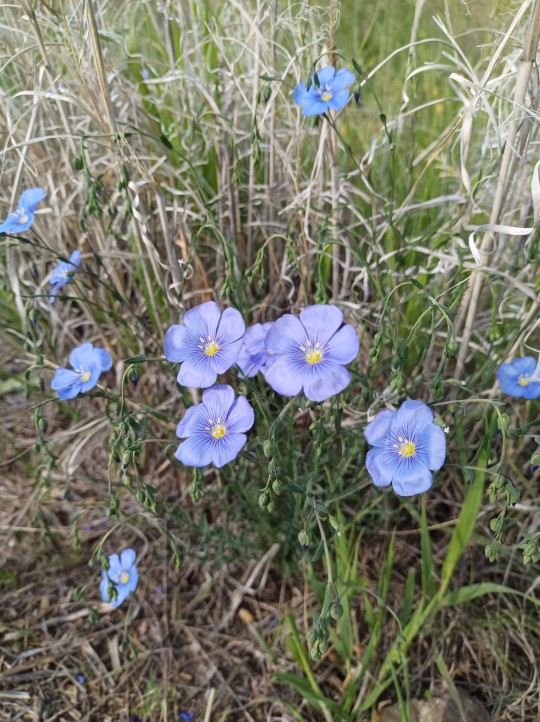
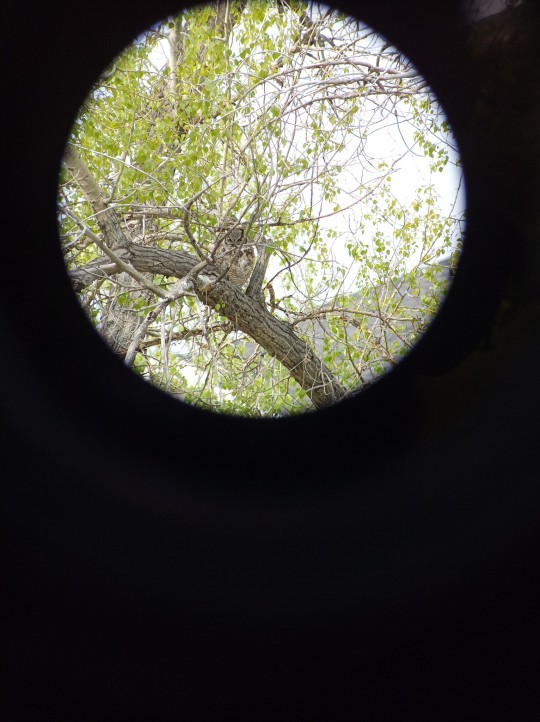
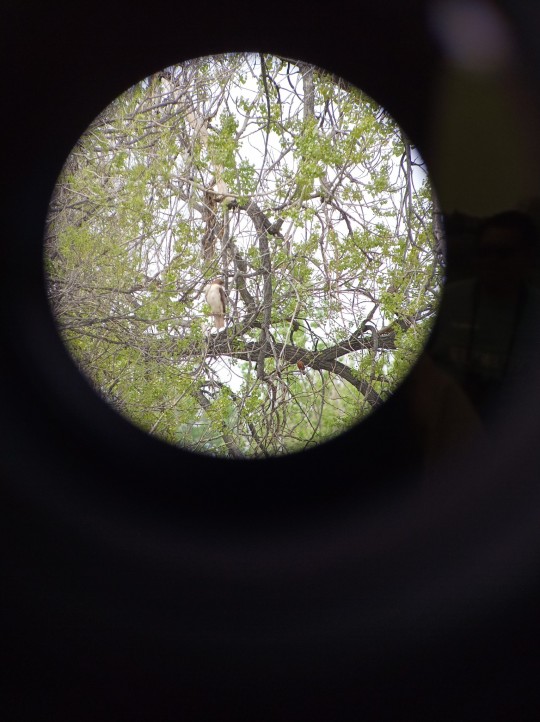
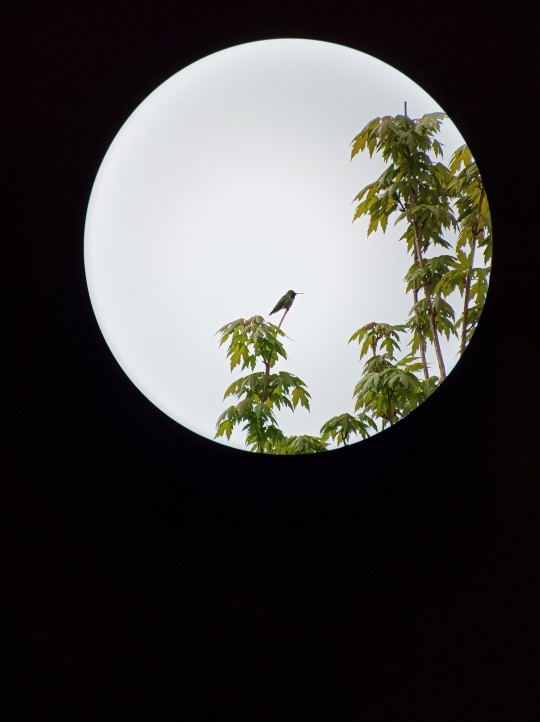

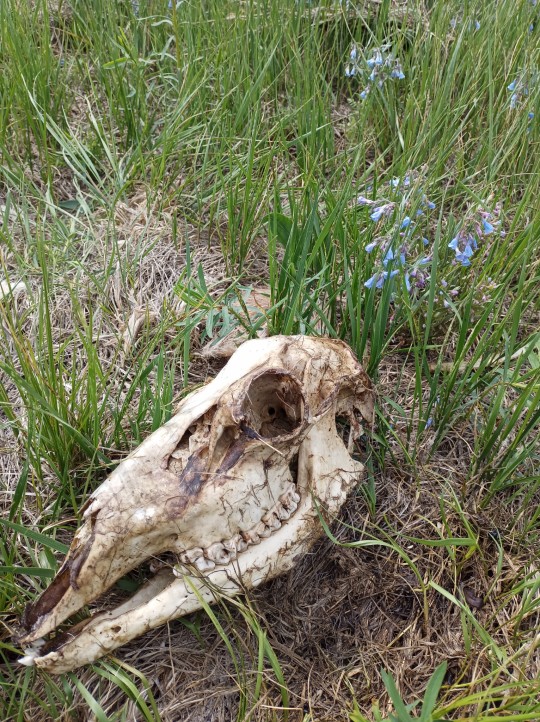
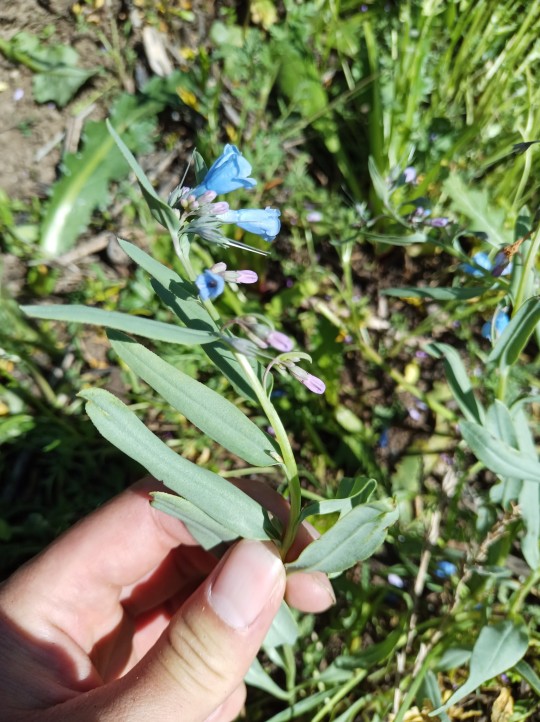

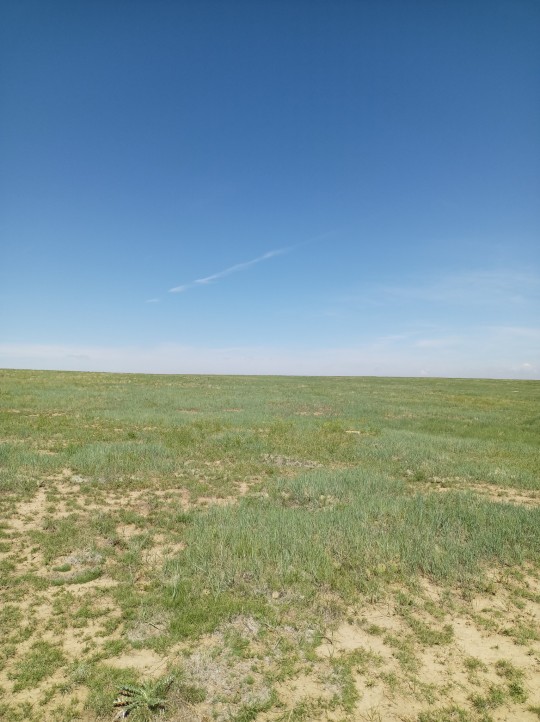
Lots of birds and flowers this week. The prairie is enjoying all the rain we've had lately.
Two-Grooved Milk Vetch and a flower I don't remember, Blue Flax, Great Horned Owl, Red-Tailed Hawk, Broad-Tailed Hummingbird, Rocky Mountain Penstemon, Rocky Mountain Penstemon and a Deer skull, Prairie Bluebells, more Milk Vetch. And blue skies, an invasive thistle, and cheat grass as far as the eye can see.
#nature#little ghost on the prairie#it's been a really long fucking month but also rewarding in a lot of ways too#flowers#birds#i'm so bad at IDing both#i'll get there#cw: dead animal#bones#deer skull#vulture culture#one of these days i'll get an actual camera...
8 notes
·
View notes
Text
I think my corn seeds have sprouted! :D
My licorice got washed down a fucking hole I had no idea was there, so now I need to get a bag of dirt to fill that in AND more licorice. >:(
But I finally have strawberry spinach!!! And sweet coltsfoot, prairie turnip, alpine yarrow, giant red paintbrush, dotted blazing star, common sunflower, yellow monkeyflower, fringed sagebrush, yellow mountain avens, wild blue flax, and gumweed. :)
Can’t believe my fucking licorice got washed down a fucking hole.
11 notes
·
View notes
Text
Notwithstanding the many disadvantages of the pioneer life, there was a charm in it which none can describe; and an old man who was here in early days almost feels like he wants to go back and live his boyhood days over in the wild new country, where everything was so near like nature formed it; he wants to see the wild animals gallop over the hills; he wants to hear the howl of the wolf; he wants to hear the cry of the hounds when pursuing the deer or the wolf; he wants to hear the gobble of the wild turkey in the spring-time; he wants to see the prairies covered with wild flowers of all colors; he wants to hear the crack of the rifle that brings down the deer or turkey; he wants to hear the "pop" of the whip as the "big brother" comes up the hill with his two yoke of faithful cattle and their big load of hickory wood; he wants to hear the thud of the flax-brake and the hum of the spinning wheel.
Except from Pioneer Life in Illinois, book by F.M. Perryman, 1907
74 notes
·
View notes
Text
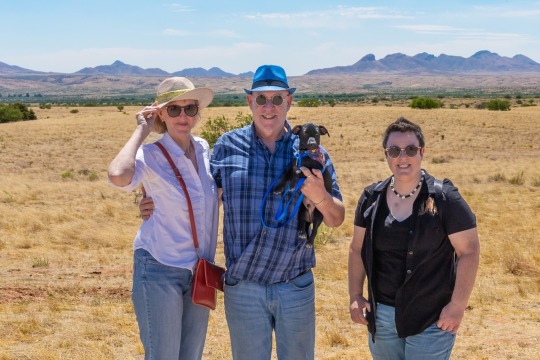

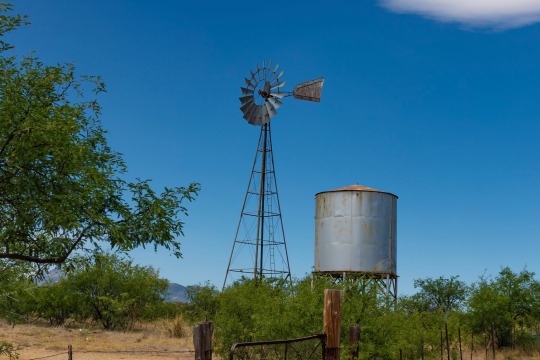
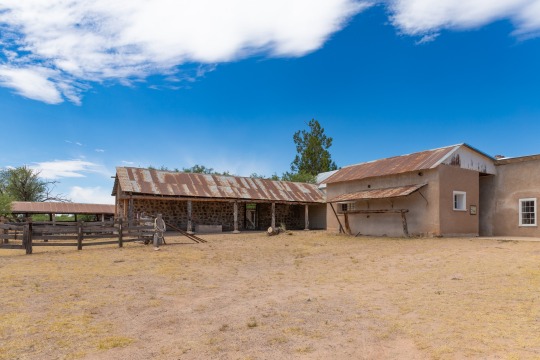

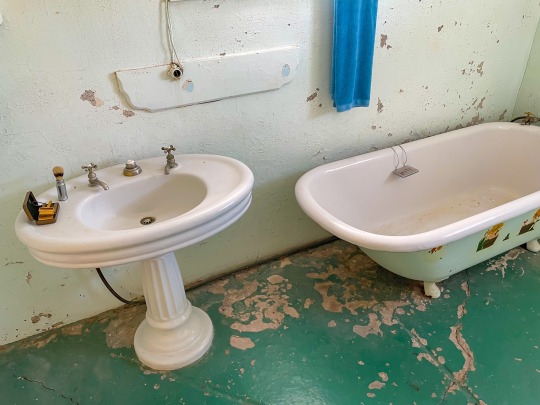
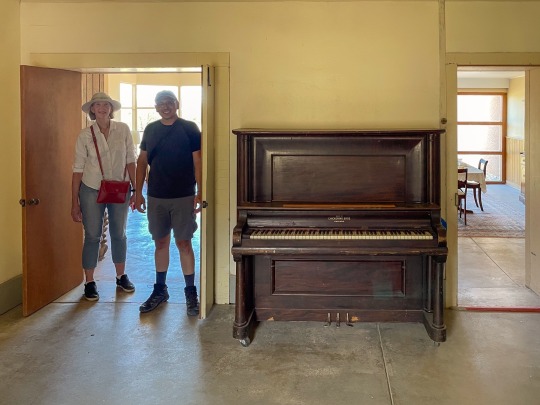
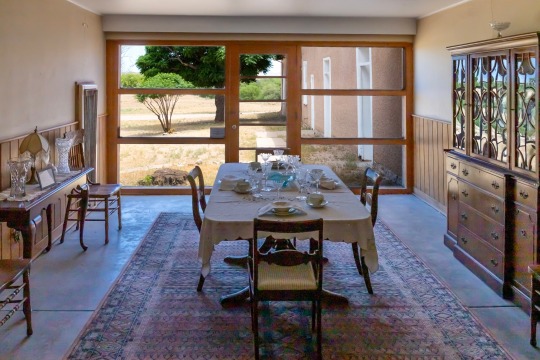
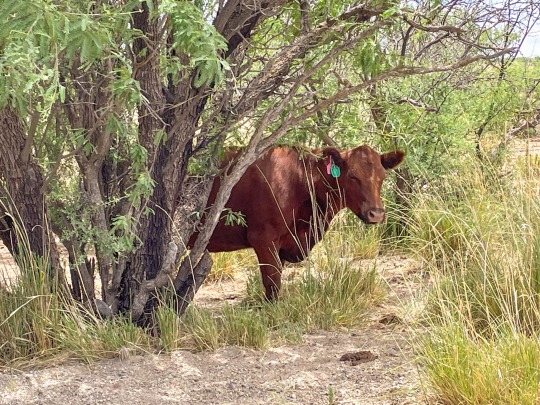

Took a drive out to Empire Ranch last week with Cindy and Dhara and, of course, Spartacus. This was Spartacus’ first day trip by car, and he did really good. He is still like a baby taking everything in. Empire Ranch dates back to 1871 and was once the largest cattle ranch in Arizona. The old ranch house is completely open to the public and on this afternoon, we were the only ones there, taking a step back in time, walking thru the various rooms filled with both rustic and refined furniture giving one a sense of the family and ranch hands that once lived there. Interesting to note that the southwest adobe house set featured in the 1976 Streisand film A Star is Born was built on Empire Ranch, but that part of the ranch is hard to access and closed to visitors. The surrounding area is grassland as far as one can see, home to antelope and prairie dogs. The salt grass was golden and dancing in the wind. We saw raptors in the sky and there were herds of cattle grazing and taking shade under mesquite trees by the side of the road. Ended our day in Sonoita at a country market. We bought all kinds of snack foods and sat outside in the shade. We feasted on flax seed crackers, humus, sharp cheddar cheese, honey roasted peanuts, Nutter Butters, spicy pickles, Hawaiian potato chips and apple pie. Spartacus had a little bowl of peas and carrots and sweet potato. 😊
#empire ranch#Sonoita Arizona#day trip#Arizona grasslands#southern arizona#queer couple#Michael Ely#mark navarro#queer rock singer#gay couple#gay musician#queer activist#queer photographer#married gay couple#tucson arizona#a star is born#barbra streisand#scenic Arizona#good friends#car adventure#trending#ranch land#ranch cattle#cute puppy#red wedding rock band#gay senior#retire gay rock singer
3 notes
·
View notes
Photo


Calendar and Alphabet Samplers stitched by Gemma Williams. Patterns designed by The Prairie Schooler.
“These 2 were stitched a few years ago and are my favorites. Done on 40 count Flax linen (1 over 2) and 40 count Sandstone linen (1 over 2).”
3 notes
·
View notes
Text
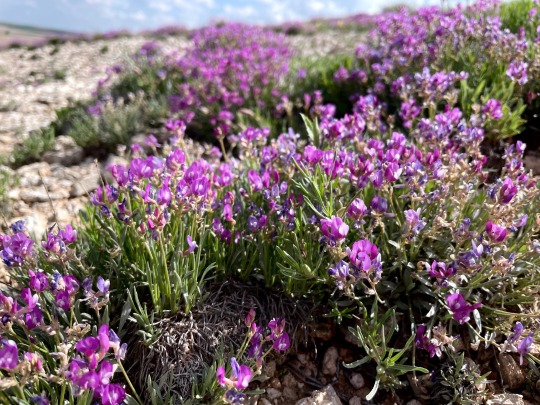






Nebraska / Wyoming Border
• Tufted Milkvetch (Astragalus spatulatus)
• Prairie Bluebells (Mertensia lanceolata)
• Lavenderleaf Sundrops (Oenothera lavandulifolia)
• Pronghorn (Antilocapra americana)
• Lewis Flax (Linum lewisii)
• Winged Dock (Rumex venosus)
• Rocky Mountain Beeplant (Cleomella serrulata)
#nebraska#wyoming#prairie#plant#plant identification#pronghorn#field research#fieldwork#outside#hike#nature hikes
5 notes
·
View notes
Text
things we found on the geode hunt
geodes
one burrowing owl on a signpost by the road. we stopped and backed up to re look at her and she hopped off and watched us from the bushes
wild horses at a distance
pronghorns. two groups of adults and little babies with huge ears and several lone horned males that were wary but not scared
horned larks (so many, everywhere)
one rabbit! saw just its little white tail disappearing down the road under the rabbitbrush (where she belongs)
one chipmunk
several ground squirrels
family of ravens on the ridge above our campsite. they had many opinions about our habits
the brightest shooting stars i have ever ever seen
red-tailed hawk (3)
little beavertail cactus with bright pink blooms
so much big wide open space :) so much pretty grass and scrub and bushland
gold-speckled spadefoot toad tadpoles in a little muddy puddle. they were very fat and came up to the surface to gulp air
fluffy fluffy foxtail grasses in patches. so green
wildflowers! bright orange-red desert globemallow with many flowers on long stalks, red-pink trumpet stalks of utah penstemon, round, tall-stemed and deep blue prairie flax, bright magenta paintbrushes, yellow and tall-stalked great mullein, yellow rabbitbrush, deep purple silvery lupine, big-petaled delicate white sego lily on thin stems rising apparently from no plant at all
halogeton with fat scarlet stems and rubbery mint-green leaves
16 notes
·
View notes
Text
Green Magic
Red Clover
Strawberry Clover
Ladino Clover
Coreopsis
White sage
Blue sage
Red sage
Gallardia Aristata
Five spot
Cornflower
Bluebell
Chinese houses
Gypsophilia
Ox eye daisy
Shasta daisy
Black eyed Susan
Rudbeckia Hirta
Candytuft
Lupine
Echinacea
Chalmomile
Viola
Sunflower (wild)
Corn (wild)
Clarkia
Poppy (California)
Gallardia
Tidy tips
Yarrow
Purslane
Larkspur
Thyme
Alyssum
Prairie clover
Lacy phacelia
Genoese basil
African daisy
Nasturtium
Indian buckwheat
Heather
Columbine
Flax
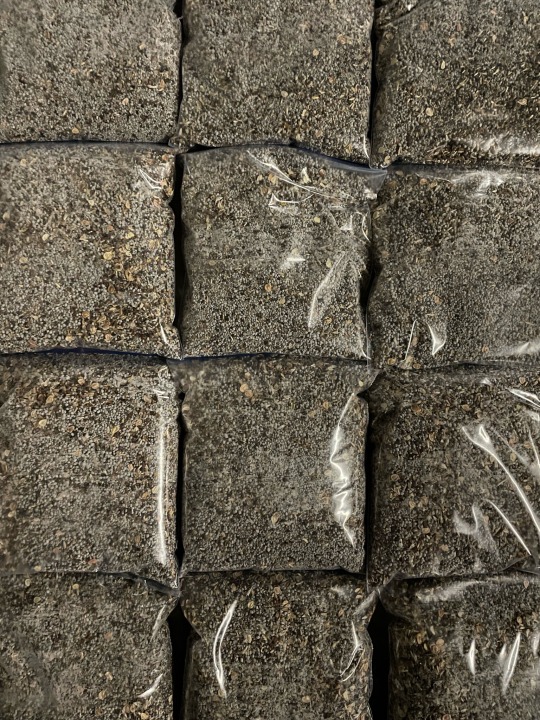
Time for some Direct Action.
2 notes
·
View notes
Link
Check out this listing I just added to my Poshmark closet: FLAX Red Linen Wide Leg Cropped Pull On Pants Sz.S.
0 notes
Text
Song of Myself (1892 version)
BY WALT WHITMAN
[…]
33
Space and Time! now I see it is true, what I guess’d at,
What I guess’d when I loaf’d on the grass,
What I guess’d while I lay alone in my bed,
And again as I walk’d the beach under the paling stars of the morning.
My ties and ballasts leave me, my elbows rest in sea-gaps,
I skirt sierras, my palms cover continents,
I am afoot with my vision.
By the city’s quadrangular houses—in log huts, camping with lumbermen,
Along the ruts of the turnpike, along the dry gulch and rivulet bed,
Weeding my onion-patch or hoeing rows of carrots and parsnips, crossing savannas, trailing in forests,
Prospecting, gold-digging, girdling the trees of a new purchase,
Scorch’d ankle-deep by the hot sand, hauling my boat down the shallow river,
Where the panther walks to and fro on a limb overhead, where the buck turns furiously at the hunter,
Where the rattlesnake suns his flabby length on a rock, where the otter is feeding on fish,
Where the alligator in his tough pimples sleeps by the bayou,
Where the black bear is searching for roots or honey, where the beaver pats the mud with his paddle-shaped tail;
Over the growing sugar, over the yellow-flower’d cotton plant, over the rice in its low moist field,
Over the sharp-peak’d farm house, with its scallop’d scum and slender shoots from the gutters,
Over the western persimmon, over the long-leav’d corn, over the delicate blue-flower flax,
Over the white and brown buckwheat, a hummer and buzzer there with the rest,
Over the dusky green of the rye as it ripples and shades in the breeze;
Scaling mountains, pulling myself cautiously up, holding on by low scragged limbs,
Walking the path worn in the grass and beat through the leaves of the brush,
Where the quail is whistling betwixt the woods and the wheat-lot,
Where the bat flies in the Seventh-month eve, where the great gold-bug drops through the dark,
Where the brook puts out of the roots of the old tree and flows to the meadow,
Where cattle stand and shake away flies with the tremulous shuddering of their hides,
Where the cheese-cloth hangs in the kitchen, where andirons straddle the hearth-slab, where cobwebs fall in festoons from the rafters;
Where trip-hammers crash, where the press is whirling its cylinders,
Wherever the human heart beats with terrible throes under its ribs,
Where the pear-shaped balloon is floating aloft, (floating in it myself and looking composedly down,)
Where the life-car is drawn on the slip-noose, where the heat hatches pale-green eggs in the dented sand,
Where the she-whale swims with her calf and never forsakes it,
Where the steam-ship trails hind-ways its long pennant of smoke,
Where the fin of the shark cuts like a black chip out of the water,
Where the half-burn’d brig is riding on unknown currents,
Where shells grow to her slimy deck, where the dead are corrupting below;
Where the dense-starr’d flag is borne at the head of the regiments,
Approaching Manhattan up by the long-stretching island,
Under Niagara, the cataract falling like a veil over my countenance,
Upon a door-step, upon the horse-block of hard wood outside,
Upon the race-course, or enjoying picnics or jigs or a good game of base-ball,
At he-festivals, with blackguard gibes, ironical license, bull-dances, drinking, laughter,
At the cider-mill tasting the sweets of the brown mash, sucking the juice through a straw,
At apple-peelings wanting kisses for all the red fruit I find,
At musters, beach-parties, friendly bees, huskings, house-raisings;
Where the mocking-bird sounds his delicious gurgles, cackles, screams, weeps,
Where the hay-rick stands in the barn-yard, where the dry-stalks are scatter’d, where the brood-cow waits in the hovel,
Where the bull advances to do his masculine work, where the stud to the mare, where the cock is treading the hen,
Where the heifers browse, where geese nip their food with short jerks,
Where sun-down shadows lengthen over the limitless and lonesome prairie,
Where herds of buffalo make a crawling spread of the square miles far and near,
Where the humming-bird shimmers, where the neck of the long-lived swan is curving and winding,
Where the laughing-gull scoots by the shore, where she laughs her near-human laugh,
Where bee-hives range on a gray bench in the garden half hid by the high weeds,
Where band-neck’d partridges roost in a ring on the ground with their heads out,
Where burial coaches enter the arch’d gates of a cemetery,
Where winter wolves bark amid wastes of snow and icicled trees,
Where the yellow-crown’d heron comes to the edge of the marsh at night and feeds upon small crabs,
Where the splash of swimmers and divers cools the warm noon,
Where the katy-did works her chromatic reed on the walnut-tree over the well,
Through patches of citrons and cucumbers with silver-wired leaves,
Through the salt-lick or orange glade, or under conical firs,
Through the gymnasium, through the curtain’d saloon, through the office or public hall;
Pleas’d with the native and pleas’d with the foreign, pleas’d with the new and old,
Pleas’d with the homely woman as well as the handsome,
Pleas’d with the quakeress as she puts off her bonnet and talks melodiously,
Pleas’d with the tune of the choir of the whitewash’d church,
Pleas’d with the earnest words of the sweating Methodist preacher, impress’d seriously at the camp-meeting;
Looking in at the shop-windows of Broadway the whole forenoon, flatting the flesh of my nose on the thick plate glass,
Wandering the same afternoon with my face turn’d up to the clouds, or down a lane or along the beach,
My right and left arms round the sides of two friends, and I in the middle;
Coming home with the silent and dark-cheek’d bush-boy, (behind me he rides at the drape of the day,)
Far from the settlements studying the print of animals’ feet, or the moccasin print,
By the cot in the hospital reaching lemonade to a feverish patient,
Nigh the coffin’d corpse when all is still, examining with a candle;
Voyaging to every port to dicker and adventure,
Hurrying with the modern crowd as eager and fickle as any,
Hot toward one I hate, ready in my madness to knife him,
Solitary at midnight in my back yard, my thoughts gone from me a long while,
Walking the old hills of Judæa with the beautiful gentle God by my side,
Speeding through space, speeding through heaven and the stars,
Speeding amid the seven satellites and the broad ring, and the diameter of eighty thousand miles,
Speeding with tail’d meteors, throwing fire-balls like the rest,
Carrying the crescent child that carries its own full mother in its belly,
Storming, enjoying, planning, loving, cautioning,
Backing and filling, appearing and disappearing,
I tread day and night such roads.
I visit the orchards of spheres and look at the product,
And look at quintillions ripen’d and look at quintillions green.
I fly those flights of a fluid and swallowing soul,
My course runs below the soundings of plummets.
I help myself to material and immaterial,
No guard can shut me off, no law prevent me.
I anchor my ship for a little while only,
My messengers continually cruise away or bring their returns to me.
I go hunting polar furs and the seal, leaping chasms with a pike-pointed staff, clinging to topples of brittle and blue.
I ascend to the foretruck,
I take my place late at night in the crow’s-nest,
We sail the arctic sea, it is plenty light enough,
Through the clear atmosphere I stretch around on the wonderful beauty,
The enormous masses of ice pass me and I pass them, the scenery is plain in all directions,
The white-topt mountains show in the distance, I fling out my fancies toward them,
We are approaching some great battle-field in which we are soon to be engaged,
We pass the colossal outposts of the encampment, we pass with still feet and caution,
Or we are entering by the suburbs some vast and ruin’d city,
The blocks and fallen architecture more than all the living cities of the globe.
I am a free companion, I bivouac by invading watchfires,
I turn the bridegroom out of bed and stay with the bride myself,
I tighten her all night to my thighs and lips.
My voice is the wife’s voice, the screech by the rail of the stairs,
They fetch my man’s body up dripping and drown’d.
I understand the large hearts of heroes,
The courage of present times and all times,
How the skipper saw the crowded and rudderless wreck of the steam-ship, and Death chasing it up and down the storm,
How he knuckled tight and gave not back an inch, and was faithful of days and faithful of nights,
And chalk’d in large letters on a board, Be of good cheer, we will not desert you;
How he follow’d with them and tack’d with them three days and would not give it up,
How he saved the drifting company at last,
How the lank loose-gown’d women look’d when boated from the side of their prepared graves,
How the silent old-faced infants and the lifted sick, and the sharp-lipp’d unshaved men;
All this I swallow, it tastes good, I like it well, it becomes mine,
I am the man, I suffer’d, I was there.
The disdain and calmness of martyrs,
The mother of old, condemn’d for a witch, burnt with dry wood, her children gazing on,
The hounded slave that flags in the race, leans by the fence, blowing, cover’d with sweat,
The twinges that sting like needles his legs and neck, the murderous buckshot and the bullets,
All these I feel or am.
I am the hounded slave, I wince at the bite of the dogs,
Hell and despair are upon me, crack and again crack the marksmen,
I clutch the rails of the fence, my gore dribs, thinn’d with the ooze of my skin,
I fall on the weeds and stones,
The riders spur their unwilling horses, haul close,
Taunt my dizzy ears and beat me violently over the head with whip-stocks.
Agonies are one of my changes of garments,
I do not ask the wounded person how he feels, I myself become the wounded person,
My hurts turn livid upon me as I lean on a cane and observe.
I am the mash’d fireman with breast-bone broken,
Tumbling walls buried me in their debris,
Heat and smoke I inspired, I heard the yelling shouts of my comrades,
I heard the distant click of their picks and shovels,
They have clear’d the beams away, they tenderly lift me forth.
I lie in the night air in my red shirt, the pervading hush is for my sake,
Painless after all I lie exhausted but not so unhappy,
White and beautiful are the faces around me, the heads are bared of their fire-caps,
The kneeling crowd fades with the light of the torches.
Distant and dead resuscitate,
They show as the dial or move as the hands of me, I am the clock myself.
I am an old artillerist, I tell of my fort’s bombardment,
I am there again.
Again the long roll of the drummers,
Again the attacking cannon, mortars,
Again to my listening ears the cannon responsive.
I take part, I see and hear the whole,
The cries, curses, roar, the plaudits for well-aim’d shots,
The ambulanza slowly passing trailing its red drip,
Workmen searching after damages, making indispensable repairs,
The fall of grenades through the rent roof, the fan-shaped explosion,
The whizz of limbs, heads, stone, wood, iron, high in the air.
Again gurgles the mouth of my dying general, he furiously waves with his hand,
He gasps through the clot Mind not me—mind—the entrenchments.
0 notes
Note
Hello! I'm looking for some masculine name ideas for a Sniper-kin ; if you want to experiment with making it earth/forest/canine themed that'd be really swag
hello!! wasn’t too sure about how masc some of these names feel, but i hope you find something you like regardless!
there's not as much as i normally end up doing, but it's still quite the list so i put them under the cut 👍.
acacia
acacius
ace
ackley
acorn
affie
alaska
alfie
alpine
arbor
arc
archer
archie
arctic
aries
arthur
artus
ash
asher
ashford
ashton
aster
atlas
august
augustin(e)
augustus
avens
avery
bandit
baron
basil
bass
basset
bay
bear
beaumont
beck
beetle
ben
bengal
benji
benny
bentley
benton
berry
birch
birk
blackjack
blaze
blue
blume
bo, boe
bolt
bone
boomer
borage
border
boxer
bracker
bracket
bramble
briar
brick
brin
brock
bryce
bryn
buck
bud
bull
burr
bush
busher
bushie, bushy
butch
buzz
caelum, caylum
callum
cane, kane
canid
canine
canyon
cas
casey
caspian
cedar
cerberus
charcoal
charlie
cheddar
chen
chez
chow
cider
ciel
cinder
citrine
citron
citrus
clay
clement
cliff
cloud
coal
coast
cobalt
cobolt
cocoa
collie
colt
columbine
columbo
columbus
conan
cooper
copper
cove
coy
coyote
crane
crimson
crispin
crow
curry
cyan
cypress
dagwood
dak
dakota, dakoda
dale
dane
dante
darrah
darren
darrow
david
dawson
deacon
dean
declan
den
denis, denys
deniz
denver
derry
dhole
digger
dill
dingo
dipper
douglas
drake
duff(y)
duke
dulce
dune
dusk
dust
dustin
dusty
dutch
dutchen
east
eden
elvis
elwood
emerald
emerson
emery
everest
everett
evergreen
falcon
fallon
fang
farley
fennec
fennel
fergus
fews
fin, finn
finch
finley, finnley
fir
firth
fish
fisher
flax
flint
florence
florent
flynn
ford
forest
forester
frank
frankie
franklin
fraser, frazier, frasier, frazer
frost
gale(n)
gardner
gene
genesis
ginger
goldie
grain
grey, gray
grove(s)
hades
harvest
hawk(e)
hazel
heath
hercules
hive
holland
hound
hugo
hum
hummer
hunt
hunter
huntie, hunty
jack
jackal
jackie, jacky
jason
jasper
jay
jett
joey
jove
july
june
juniper
juno
jupiter
kai
kale
kestrel
kip
kippy, kippie
koa
koi
lake
lark
leo
loch
locust
lodge
lotis
lotus
lucky
lumen
lupin(e)
lupis
mace
magnus
mane(d)
mango
march
marley
marlow
marsh
marshal(l)
matchbox
maverick
max
meek
meer
merlin
mickey
mint(y)
mob(y)
moose
morgan
morris
moses
moss
mossy, mossie
nash
nasher
nicholas
noble
norman
north
nox
oak
oakie
odie
odin
oleander
olive(r)
olivier
ollie
oto
otter
otto
ottoman
packet(t)
pear
percival
percy
perry
perseus
picard
pickle
pine
pongo
prairie
prince
red, redd
reed, reid
ren
rhodes
rhody
ridge
rock(e)
rocky, rockie
roman
ronat
rook
root
rory
rover
rudy
rune
russel
salmon
samsun, samson
scruff
scruffy, scruffie
silver
silvester
skylark
smokey
sol
solei(l)
solomon
sorrel
south
spade
sparrow
spot
spruce
stag
sterling
stone
sun
sunray
talon
tawny
terran
terro
terry, terrie
theo
thistle
thor
thyme
titan
toms
trip
tunnel
turtle
velvet
vulp
vulpes
wade
wane
warbler
wax
waxer
weaver
wells
west
whistler
winston
wolf(e)
wood
woodrow
woodson
woody, woodie
york
zeus
#request accepted | ''Allons-y; Allonzo!''#anonymous request#name suggestions | ''How would you feel about Who?''#tf2kin#tf2 kin
0 notes
Text
Getting Over Canola
Prairie crossingsKeeping timeWith the endless swagOf powerlines
Skimming alongThe road unreelsMile after mileO’er canola fields
IntersectionsAnd railway linesBreak the monotoneWith highway signs
This poem’s kinda wonkyNow that’s a factBut canola‘s tough to work withI wish it was flax
Continue reading Untitled

View On WordPress
#bad poetry#Canada#driving#farming#highway#photogaphy#postaday#prairie#rural life#Saskatchewan#travel
0 notes